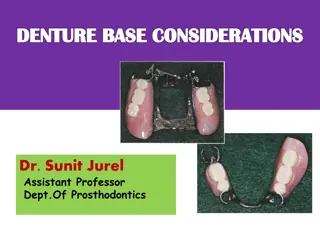Understanding Relining and Rebasing Procedures for Dentures
Relining and rebasing are crucial procedures in dentistry to maintain the fit and functionality of dentures. Relining involves resurfacing the tissue side of a denture to improve adaptation, while rebasing replaces the entire denture base material without altering the dental arch or occlusal relatio
1 views • 21 slides
Understanding Repair and Addition to RPD in Dentistry
The need for repair or addition to an existing Removable Partial Denture (RPD) often arises due to various factors like occlusal disharmony, improper handling, or fatigue of metal components. Common fracture sites include midline, clasp fracture, and acrylic saddle detachment. The repair procedure i
1 views • 16 slides
Understanding the Sequelae Caused by Wearing Complete Dentures
Denture use can lead to various sequelae, including denture stomatitis, angular cheilitis, flabby ridge, traumatic ulcers, and more. These issues can cause discomfort, destabilization of occlusion, loss of retention, decreased masticatory function, poor aesthetics, and increased ridge resorption. Fa
2 views • 58 slides
Common Errors in Complete Denture Insertion and Selective Grinding Techniques
Errors in complete denture construction can arise from technical mistakes in the clinic or laboratory, as well as material deficiencies. The use of intraoral selective grinding techniques like articulating paper and occlusal indicator wax can help correct errors in occlusion and balance for better d
0 views • 6 slides
Understanding Dentist-Laboratory Relations in Dental Prosthodontics
The relationship between dentists and dental laboratory technicians is crucial for the successful fabrication of dental prostheses. Dentists delegate the construction of prostheses to technicians based on instructions, but lack practical experience in framework construction. Proper communication and
1 views • 23 slides
Daily Hygiene Activities and Skills for Healthcare Professionals
Enhance your occupational knowledge and skills in performing basic hygiene and activities of daily living in laboratory and clinical settings. Learn about oral hygiene, denture care, and eyeglass maintenance essential for residents and patients. Discover the importance of daily hygiene and its benef
0 views • 15 slides
Managing Eating and Swallowing Challenges After Stroke
Dysphagia, a common issue after a stroke, can lead to difficulty swallowing and may require texture modifications in food and fluids for safety. Up to 65% of stroke survivors may experience dysphagia, which can lead to complications like pneumonia. Proper oral care, mealtime positioning, and awarene
0 views • 9 slides
Understanding Stress Breakers in Removable Partial Dentures
Removable partial dentures in dentistry encounter various stresses, with Class I, II, and IV being more susceptible than Class III due to the need for support from both teeth and soft tissue. Stress breakers and equalizers play crucial roles in managing and distributing stresses effectively on abutm
0 views • 25 slides
Comprehensive Removable Partial Denture Base Information
Learn about the materials used for denture bases, the most retentive types, strength considerations, spacing requirements, and lingual bar shapes for mandibular dentures through a series of questions and answers with image references.
0 views • 6 slides
Understanding Denture Base Considerations in Prosthodontics
In prosthodontics, denture base considerations play a crucial role in the design and fabrication of removable partial dentures. This comprehensive guide covers the definition, requisites for an ideal denture base, functions, types (plastic and metal), and advantages of metal bases. Key factors such
0 views • 33 slides
Overview of Prosthodontics Laboratory Procedures in RPD Construction
The process of blockout and relief in removable partial denture construction involves eliminating undesirable undercuts on the master cast to ensure the framework can fit properly. Beading and blockout techniques are described for both maxillary and mandibular casts, emphasizing the importance of pr
0 views • 10 slides










